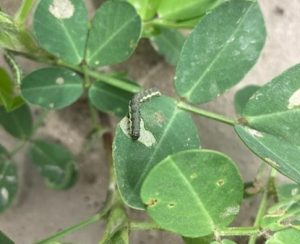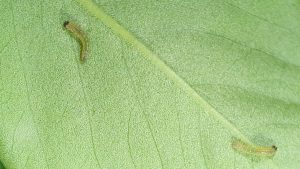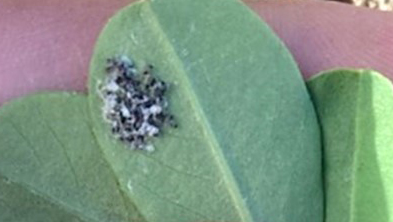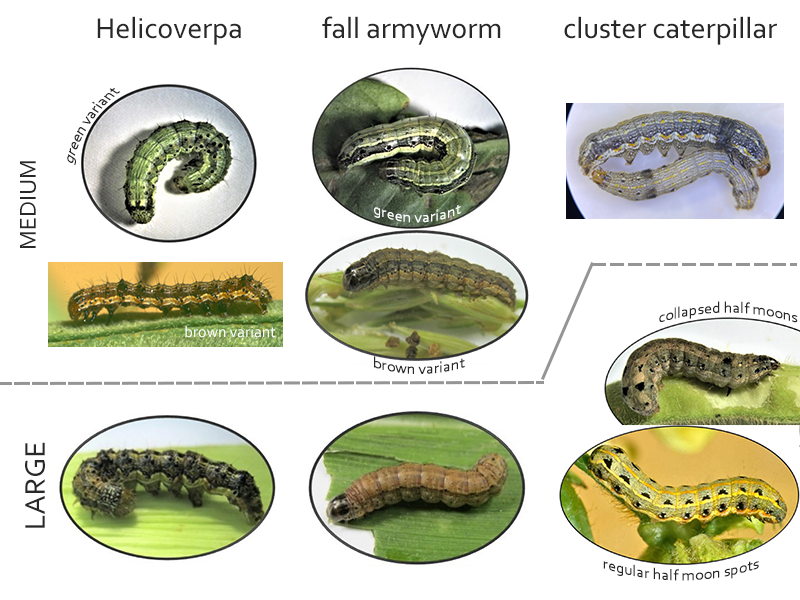
Larva causing windowing damage to a peanut leaf
Since early 2020, growers and agronomists have been nervous about the prospect of fall armyworm (FAW; Spodoptera frugiperda) invading their crops. So far, the majority of significant and damaging FAW infestations have been recorded from sweet corn, maize, and sorghum crops, with some isolated outbreaks in horticultural crops such as ginger and capsicum. Occurrences in other crops have been a result of FAW moving in from either adjacent corn or sorghum crops, forage sorghum windbreaks, or from weeds and volunteers within the field.
Recent reports of sizeable populations (≥12/m2) of caterpillars in young peanut crops around Bundaberg were initially assumed to be mostly FAW, but on closer inspection, three quarters of the caterpillars were identified as being Helicoverpa armigera. This (and similar reports from other crops) highlights the importance of correct identification in making pest management decisions. While FAW can certainly occur in large numbers, it should not be assumed it is the only caterpillar capable of outbreaks in crops.
Some key points:
- Spodoptera and Helicoverpa species can be difficult to distinguish, but a few key features provide reasonably reliable identification as larvae grow.
- Several products are registered or under permit for caterpillar control in peanuts, including biopesticides (nucleopolyhedrosis virus, NPV) for both Helicoverpa and FAW that are soft on natural enemies.
- Damage to leaves during the vegetative stage is unlikely to warrant control unless there is considerable defoliation.
Identifying caterpillars
Identification of pest caterpillars, particularly during their early instars, can be quite difficult. While the larvae pictured on this leaf are FAW, no characterising elements have yet appeared. As they grow, caterpillars develop more distinguishing features. So if you’re unsure what a small larvae is, it’s a good idea to collect, along with some plant host material, and let the larvae develop until key features develop – usually 2-4 days is long enough. Medium (about 3rd instar) and older larvae become easier to tell apart, although they often may still look similar to the casual observer, particularly as there can be a wide range of colour variation between individuals of the same species.

Identification of early instar larvae is difficult (these are FAW)
The caterpillars most likely to be present in vegetative peanuts in large numbers are helicoverpa, FAW and cluster caterpillar (Spodoptera litura). On closer inspection, some differences among morphological features become apparent, although not all characteristics described below will be visible on all specimens, and all species can have a wide range of colour variations. You are more likely to get a correct identification when taking all potential identifying features into account rather than just one or two, as some characteristics occur in more than one species.
- Longitudinal stripes: Spodoptera have 3 distinct thin pale lines running along the dorsal (top) side of the body. In cluster caterpillars these often have a yellowish tinge and are accompanied by dark half-moon spots. If a dorsal stripe is present on Helicoverpa it is usually a single centre line.
- Dark spots: medium FAW and Helicoverpa have sets of small dark raised bumps, with a distinctive pattern of 4 in a square cluster on the second last segment that become more prominent on FAW as they grow. Cluster caterpillars have four rows of larger dark spots or semicircles along the body, spaced at one dark spot per segment within in each row.
- Dark ‘saddle’: Medium cluster caterpillar often display darker pigment on about the fourth segment behind the head, which disappears as the larvae grows. The saddle may also be visible on medium Helicoverpa armigera larvae, but is not seen on FAW.
- Body hairs: medium FAW and Helicoverpa have noticeable hairs, while cluster caterpillar tend to be smooth. FAW lose this hairiness as they progress to large larvae.
- Markings on head capsule: The two Spodoptera species have an inverted pale ‘Y’ visible on their head capsule, with the base of the Y leading to the central longitudinal body line. Helicoverpa lack the obvious Y and are more likely to have random patterning on the head and upper thorax areas.
- Overall physique: Helicoverpa larvae often appear more ‘muscular’ than Spodoptera species, which both develop a ‘plumpness’ as they grow. Older FAW larvae in particular often have a ‘greasy’ appearance.
Summary of characteristics:
| Helicoverpa | FAW | Cluster caterpillar | |
| Longitudinal stripes | 1 (centre) | 3 (creamy) | 3 (yellowish) |
| Dark spots | small raised | small raised | large blotches |
| Saddle (medium instars) | sometimes | absent | usually |
| Hairs along body | noticeable (med+large) | present (med only) | absent |
| Head area | patterned | pale Y | pale Y |
| Physique (large instars) | lean | plump | plump |
Another difference is helicoverpa lay single eggs, whereas both Spodoptera species lay eggs in batches, often covering the eggs with scales. Cluster caterpillars tend to stay in the vicinity of the egg mass, while newly hatched FAW can disperse by ‘ballooning’ (floating off the plant using webbing).

FAW egg mass hatching
If taking photos of larvae to confirm identification, take them from as many angles as possible, but particularly try to get clear images of the front, back, sides and top to have a better chance of capturing any distinguishing features. See our factsheet for some handy hints.
Management options
Correct identification of these caterpillar pests is critical to determine the appropriate insecticides or biopesticides (registered or under APVMA Permit) for application in peanut crops. Chlorantraniliprole (Altacor®, Vantacor®) is available for Helicoverpa and FAW (PER86014) and cluster caterpillar (PER90481) in peanuts, while indoxacarb (Steward®) can be applied against FAW under permit PER90577. While there is a permit (PER89279) for using methomyl (Lannate) against FAW, using this product is not recommended as FAW are resistant to group 1A carbamate insecticides, and spray failures are likely. Additionally, methomyl has both a very short residual activity and is very hard on natural enemies. Chlorantraniliprole on the other hand appears to be the softest of available non-biological products on natural enemies.
Biopesticide options are also available. While they may not have quite as high an efficacy as conventional insecticides, they are specific to the pest species, are often sufficient to bring populations down below damaging levels and have no impact on beneficial insects. If the current wet weather continues, peanuts will be growing vigorously and will be better able to compensate for defoliation.
- Helicoverpa-specific NPV (nuclearpolyhedrosisvirus) is commercially available in ViVUS® products and Gemstar®. These products are most effective when applied with a high spray volume and have been successful when applied through centre pivots. For optimum results, target small helicoverpa larvae (<7 mm long) and ensure good coverage.
- For FAW, there is a specific viral product Fawligen® under permit (PER90820). This product also requires good spray coverage, and is only effective against 1st and 2nd instar FAW. It has no impact on Helicoverpa. Users must be accredited – Visit the AgBiTech website for more information.
Economic threshold levels
Helicoverpa thresholds are currently 33% defoliation at the vegetative stage and a nominal threshold of 4-5 helicoverpa/m2 in flowering peanuts (based on a field trial which showed no yield loss for populations of 3-4/m2). However, further trials are required to determine yield loss and confirm threshold levels.
Recent US studies show that FAW inflicts similar damage in peanuts to H. zea (the American equivalent of H. armigera). We are currently conducting trials to examine FAW establishment on and damage to peanuts. In the interim, the current thresholds for H. armigera could be considered a ‘best bet’ for both FAW and cluster caterpillar. Preliminary results from glasshouse experiments indicate that while FAW will lay eggs and early instars can establish feeding sites on peanut plants, the larvae are not as healthy as those feeding on maize.
Avoiding hard options and going soft early will to facilitate a build-up beneficials to reduce the risk of (a) subsequent caterpillar attacks, and (b) flares of secondary pests such as mites and whitefly.
Please report any caterpillar outbreaks in peanuts you suspect of being FAW to Hugh Brier or Trevor Volp (see contacts page).
Article by Hugh Brier and Trevor Volp. Photographs by Hugh Brier, Trevor Volp, Sharna Holman, Joe Wessels and Pablo Ubilla.

